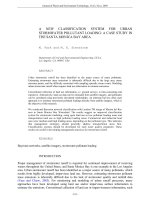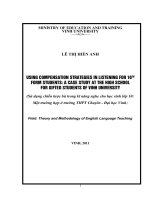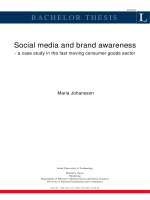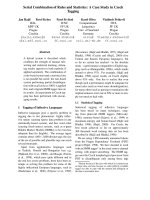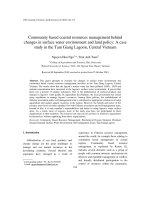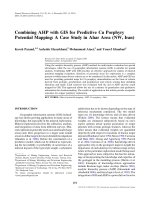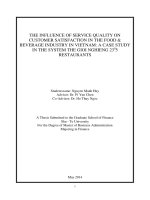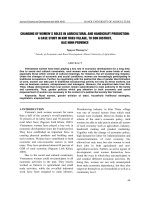Practical techniques of dancing and musical movement for 5-6 years old kindergarten children (a case study in the kinder practice school, Thua Thien Hue College of Education)
Bạn đang xem bản rút gọn của tài liệu. Xem và tải ngay bản đầy đủ của tài liệu tại đây (428.44 KB, 5 trang )
No.24_December 2021
TẠP CHÍ KHOA HỌC ĐẠI HỌC TÂN TRÀO
ISSN: 2354 - 1431
/>
PRACTICAL TECHNIQUES OF DANCING AND MUSICAL MOVEMENT
FOR 5 - 6 YEARS OLD KINDERGARTEN CHILDREN
(A CASE STUDY IN THE KINDER PRACTICE SCHOOL,
THUA THIEN HUE COLLEGE OF EDUCATION)
Hoang Thi Diem Trinh
Thua Thien Hue College of Education, Viet Nam
Email address:
/>
Article info
Abstract:
Received: 1/9/2021
Accepted: 1/12/2021
Keywords:
dancing, musical
movement, dancing skill,
movement, kindergarten
children
Dancing and musical movement are important subjects of the musical
educational curriculum in the kindergarten. Using our practical experiences
during the implementation of the kindergarten teacher training curriculum,
we propose novel practical techniques of dancing and musical movement
training for the 5 - 6 years old children, aiming at contributing useful
documents and techniques for efficient training of children in the
kindergarten.
|139
No.24_December 2021
TẠP CHÍ KHOA HỌC ĐẠI HỌC TÂN TRÀO
ISSN: 2354 - 1431
/>
BIỆN PHÁP RÈN LUYỆN KĨ NĂNG MÚA - VẬN ĐỘNG THEO NHẠC
CHO TRẺ MẪU GIÁO 5 - 6 TUỔI (NGHIÊN CỨU TRƯỜNG HỢP
TẠI TRƯỜNG THỰC HÀNH MẦM NON TRỰC THUỘC
TRƯỜNG CAO ĐẲNG SƯ PHẠM THỪA HUẾ)
Hoàng Thị Diễm Trinh
Trường Cao đẳng Sư phạm Thừa Thiên Huế, Việt Nam
Địa chỉ email:
/>Thông tin bài viết
Ngày nhận bài: 1/9/2021
Ngày duyệt đăng:
1/12/2021
Từ khóa:
múa, vận động theo nhạc,
kĩ năng múa, vận động, trẻ
mầm non
Tóm tắt
Múa - vận động theo nhạc là một nội dung quan trọng trong hoạt động giáo
dục âm nhạc ở trường mầm non. Với kinh nghiệm từ thực tiễn trong đào tạo
giáo viên mầm non và hướng dẫn trực tiếp trên trẻ, trong bài viết này chúng
tôi đề xuất các biện pháp rèn luyện kỹ năng múa - vận động theo nhạc cho
trẻ mẫu giáo 5 - 6 tuổi nhằm cung cấp nguồn tư liệu mới trong hoạt động rèn
luyện kĩ năng cho trẻ đạt hiệu quả.
1. INTRODUCTION
In the kindergarten, musical education potentially
impacts on the children, given a variety of activities
of teaching the music, listening to the music and
singing, dancing and musical movements (D&MM),
musical games. In addition to the general knowledge
and musical practices, the D&MM constitutes a
considerable content in the curriculum. The D&MM
is not only supports to develop the feeling of the
rhythm, the movement and quick response skills to
the musical forms, but help to harmonize the emotion
of the children. The activity D&MM provides the
kinder children a convenience approach of body
movement understanding, deep interaction to friends,
emotion sharing to compare and select their favourite
movements.
Due to the psychological characteristics of
innocence and active playing in the kinder and the
5 – 6 years old children, the relationship between
music and movement is easy to established and might
reach to a skillful level in the group of 5 – 6 years old.
The implementation of the D&MM methods, hence
140|
is very important to better facilitate essential skills in
D&MM for the children at a higher education. Our
field survey in the kinder practice school (Thua Thien
Hue (TTH) College of Education (CoE)), however
indicates a less effective implementation of the
D&MM program, which might be attributed of the
curriculum design, dance practice, teaching skill, and
supplementary equipment. This study aims to propose
effective approaches of the D&MM practices for the
5 – 6 years old children, and is expected to provide
a general D&MM framework implementation in the
kindergarten in the future.
2. CONTENT
2.1. D&MM background
2.1.1. D&MM definition and skill
a. Dancing: Tran Minh Tri defines “Dancing is
an independent art using the movements and forms
of the human body, with the musical tempo and body
formation to express the ideas and emotions” [6],
whilst Dinh Xuan Dai presents “Dancing is an art
with independent language of high abstraction and
Hoang Thi Diem Trinh, et al/No.24_Dec 2021|p139-143
stylization. The dance is neither not the daily movement
nor to support the song lyric or other arts. Conversely,
the independent dance movement is used to express the
ideas, emotions, or specific topics through a series of
movement or a completed dance complex” [2].
different materials, images in a high requirement of
accuracy and uniformity [5].
The above definition supports a generalization
of the dance as an independent art, which uses
the movements, gestures of the human body with
different tempos and styles to present the ideas and
emotions of the artists.
2.1.2.
Characteristic
of
psychological
development and D&MM capability of the 5 – 6 years
old children
- Dance in the kindergarten: Dance is an attractive
topic with the people, especially the children, fitting
to the visual and image minding. The kindergarten
dance is usually simple with the movements
visualizing from the song lyrics to help the children
easily understand and feel the motions. Comparing
to the festival and performance occasions, the dance
lesson is designed more elementary for the daily
training in the kinder class.
b. Musical movement: the human body movements
to express the ideas, rhythm of a musical piece or
tempo of a given song. Musical movement is a form
of the dance at simple level and is appropriate with
any age children [3].
For instance: The simulated motions of the cradle
movement or lullaby when performing the song
“Ru em” of Hoang Kim Dinh can be expressed as a
gentle shaking of the human body following the song
melody and the clapping by the song rhythm.
- Musical movement in the kindergarten: a
combination of the music and dance movement or
a usage of the musical toys accompanimenting with
the music to foster a feeling in musical rhythm,
contributing to the intellect and physical health of the
children. The movement is very elementary in design
to fit the children capability and the kinder musical
structure [5].
c. Dance and musical movement (D&MM)
technique classification:
- Dance technique:
+ Technique 1: Game dancing/ group dancing are
simple dance lesson visualizing for any songs that the
children learns during the class. The requirements of
dance skill and accuracy is not high to fit the overall
performance of all the children. In the dance practice,
the children are not required to move by group and
only express their own characteristics.
+ Technique 2: Performance dancing is served
in the festival, musical competition or other art
performance. This form requires higher dance skills,
integrating various factors of group movement,
cooperating with partners, diverse dancing with
- Musical movement: is designed as the training of
clapping/percussion to the song beat and rhythm at a
variety of fast, slow and changing speed.
a. Characteristic of psychological development: A
diverse imaging and amusing creation are the typical
development in psychology. At this age, the children’s
thinking is developed with the curiosity of inside
feature, rather than outside character of the objects.
The detail and vivid attributes of colour, sound have
a strong impact on the children’ sense and leave a
significant imprint on the children’ thinking. The 5 –
6 years old group is capable of longer concentration,
well-developed sense and better feeling of the
musical forms, including the song’s beat, rhythmn,
tempo than other ages [4].
b. Dancing characteristic the 5 - 6 years old children
At the higher class in the kindergarten, the
children’ movement reaches to a skillful level
with a better feeling/ understanding of the musical
forms, and hence the D&MM implementation is
highly suggested to this children group. A flexible
movement of various muscle groups supports to
combine different gestures of hand, foot, and the full
body. The children is able to keep the balance on one
leg, to carry out, for instance, the footing jump or
the moving surround the partners. The capability of
controlling and using the narrow amplitude gestures,
however is still limited and therefore, the teacher
need to compose the D&MM lessons fitting to the
children’ skills [2].
2.2. Proposal approaches of the D&MM practice
for the 5 - 6 years old children
2.2.1. Establishment of the overall and detail
teaching plan
* Purpose: supports the teacher an overall look at
the D&MM contents in a long-term period of yearscale, then actively builds the detail plan weekly
and operates the practice systematically. The longterm planning ensures a inheritable and continuous
practice for the kinder children.
* Implementation:
- The teacher make a teaching plan for one year
from the designed topics in the curriculum.
- Creating of detail plan for months with sub-topics.
- Designing the week plan.
|141
Hoang Thi Diem Trinh, et al/No.24_Dec 2021|p139-143
- Add the bake-up plan for anomaly changes of
children’ absence, less effective practice, or overlapping
with the kinder curriculum. Following this approach,
the D&MM is conducted systematically, and help the
teacher prepare the lesson in a professional manner.
* Purpose: to help the children be acquainted with the
musical equipment and novel multi-medias, which
make interest and motivate the children during the
training.
2.2.2. Selection of song for D&MM content
development
- Visual educational equipment can be selected
from the designed period and D&MM topics. For
instance, the teacher may use a rabit-shape cap to
practice the song “Troi nang troi mua” of Dang Nhat
Mai, or paper flower with the song “Mua voi ban Tay
Nguyen” of Pham Tuyen to make more interest. The
musical instruments of saxophone, beat bar, wooden
bell, drum are all essential and used in the teaching of
clapping/ percussion D&MM.
* Purpose: to create the D&MM lesson fitting the
development of the children’ thinking and movement,
support the teacher more effective lessons, and
improve essential skills for the children.
* Implementation: The teacher need to select
the song for D&MM content development from the
designed plans and the song should be popular to
the children daily, which is simple enough to sing,
remember with the movement to ensure the D&MM
requirements.
- The song should not to be so easy or difficult to
the age of the children or the song with too fast/ too
slow rhythm, unclear image and content is not in the
selected list.
- A subtle observation is required to analyze the
children capability, and design the outputs for each
lesson and the children group.
- Prioritize the D&MM content that suppose to
develop the children skills.
- Refer to and collect quality D&MM lessons to
diversify the novelty content and ideas.
2.2.3. Movement accurateness
* Purpose: create an idol model for the children
to follow, learn the skill accurately, inculcating the
impression and emotionally recognize the movement.
* Implementation:
- The teacher is required to cultivate and practice
the D&MM skill to be an idol model in the children
thinking. The gesture need to be accurate, beautiful
with appropriate nuance to the selected songs. If the
children is capable of inculcating the impression,
emotional feeling the dance/ movement, the
movement accurateness can be obtained in a short
time of training.
- The D&MM is an creative activity and therefore,
the teacher should give the opportunity of creative
expose to the children to support a self-building of
sensory and thinking movements. Thereafter, the
teacher implements the movement with a short and
understandable description, which help the children
an effective learning in the class.
2.2.4. Active application of educational equipment
142|
* Implementation:
- The teacher need to create a diverse collection
of D&MM equipment, using a variety of different
materials of bamboo bar, paper flower, knot… to
maintain a new emotion of the children during the
training. However, the children should avoid to use
these equipment when their D&MM skills are not well
developed since they easily loose the concentration
in the class. The selection of educational equipment
is suggested to precisely follow the lesson content
and the children’ development to gain the highest
effectiveness.
2.2.5. Game in the D&MM
* Purpose: to motivate an active practice without
boring during the training, and make the children
more comfortably and interest to the D&MM.
* Implementation: The kinder children always
want to play and be a member in the game. Therefore,
if the teacher is able to transfer the playing to the
learning motivation for the children, the D&MM
training might obtain results beyond expectations.
For instance, after guiding the children practice the
D&MM with the song “Chung minh la nghe si”, the
teacher organizes a competition among the artist
groups of drum, guitar, flute, then selects the best
group through the voting. A competition is an typical
example, which make the children interest to the
movement, repeating the training with new energy
and motivate the children a self-performance.
2.2.6. Creating diverse forms of motivation and
encouragement
* Purpose: to arouse the children’ confidence and
boldness. The children desires to present the skills
and actively practice the D&MM when they learn in
a encouragement manner.
* Implementation:
- The teacher uses different forms of motivation
and encouragement, including the positve comment
Hoang Thi Diem Trinh, et al/No.24_Dec 2021|p139-143
and applause after practice activity, reward for
beautiful dancer, ten minutes as the teacher for the
best dancer. The motivation and encouragement bring
the children positive attitude and also remind others
to keep the practice.
- The selection of the motivation and encouragement
forms is important and depending on specific cases. If
the children practices unwell, the teacher should use
the positive comment or applause talk, rather than
criticizing or reproaching which might result in the
boredom hatefulness during the training.
2.2.7. Open opportunity of developing and
practicing the talent
* Purpose: to facilitate the optimal environment
for the practice, develop the talent of the children in
the learning and playing in the kindergarten.
* Implementation:
- The teacher should not limit the opportunity
inside the class, but to give the children a chance
to practice at any time and places. For instance, the
morning exercise with the topic “Career” can be
combined with the song “Em thich lam chu bo doi” of
Hoang Long, or the song “Chu bo doi” of Hoang Ha
to motivate the children with movement, footing, and
integrate with extra gestures of carrying a gun on the
shoulder and walking. The musical movement in the
exercise is a typical example to support the children
with better skills of the D&MM.
- Integrate the practice into other lessons.
Examples can be a movement with the song “Tap
dem” of Hoang Cong Su in the math lesson, the song
“Do ban” of Hong Ngoc in the science lesson which
suppose a recognition of the animals, or the song “Chu
bo doi” of Hoang Ha in the drawing lesson to depict
the soldier. A flexible combination makes the children
more interest, changes the forms of movement, and
actively improve essential D&MM skills.
- Organize a group watching of dancing,
aerobic activities with the television or outside art
performance. This activity motivates the children to
compare and select their own best gestures.
opportunity of practice and performance. The teacher
should be interested in and guiding the talent children
soon to support their potential success at higher
education in the future.
3. CONCLUSION
We proposed seven (7) approaches to practice
the D&MM for the 5 – 6 years old children in the
kindergarten with a case study in the kinder practice
school, Thua Thien Hue College of Education. The
purpose and implementation were detail described
in each of approach, providing the novel material
and guidance document for the teachers in the
kindergarten. During the implementation of the
D&MM, the teacher should integrate a variety of
different approaches – as indicating in this research
- to fit the kindergarten and children characteristics
in different regions in Vietnam. Further extending of
the proposed approaches to other kindergarten and
educational fields is undergoing in the near future.
REFERENCE
[1] Denomme, JM & Roy, M (2000), Approaching an
interaction education method, Thanh Nien publishing
house.
[2] Dai, D.X. (2007), Textbook Dance and educational
method of musical movement, Ha Noi publishing
house, page 12.
[3] Hoa, P.T. (2009), Textbook Music education method
in the kindergarten, College of Education publishing,
pages 15, 73-77.
[4] Huong, L.T, Hien, L.T, Hoa, P.T, Duc, L.T. (2007),
Organizing integrated music activity for kindergarten
children, Education publishing house, pages 12 – 13.
[5] Le, T.T. (2017), Limitation in music education
for kindergarten children and solution, Journal of
Education, special issue 12/2017, page 71 – 76.
[6] Tri, T.M. (1999), Textbook Dance and music
movement education method, Education publishing
house, page 8 – 9.
[7] Tuyet, N.A, Mai, N.N, Thoa, D.K. (2014),
Kindergarten children psychology, Ha Noi National
University publishing house.
- Select the talent children for different art
groups in class or school to bring the children more
|143
